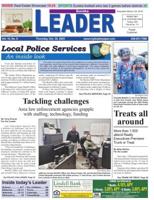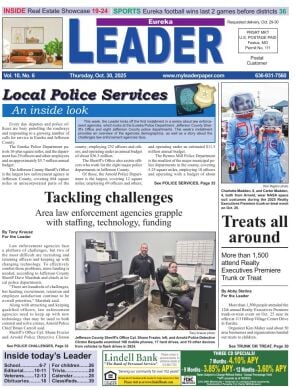After she found a cache of old photos and postcards inside the mantel of a De Soto home during a renovation, Wanda Sasenger tried unsuccessfully for nearly a decade to learn the identities of those featured in the pictures.
Eventually, she appealed to the Jefferson County Heritage and Historical Society for help and got her answers, thanks to the investigative prowess of the society’s secretary, Kay Clerc-Fakhar, who routinely receives those sorts of requests.
“It seems a day doesn’t go by without an inquiry from various sources who have an interest in Jefferson County’s history,” she said.
Clerc-Fakhar, 61, used a number of resources to track down the home’s former owner, Samuel Prentiss, and the photos have been returned to his descendant, Scott Stanton, now living in Colorado.
Clerc-Fakhar used similar techniques to hunt down the identity of a woman featured in a Victorian-era charcoal drawing, who turned out to be Mary Jo Knox Sherrick, the great-grandmother of local realtor Rob Terry.
“We had no idea (the portrait) even existed,” Terry said. “My dad, Gene Terry, has passed away, but my mom said the family lived in Arkansas and some moved out to the West Coast.”
The portrait was discovered in a thrift store in Oregon.
“I’m just speculating, but it could be that, when they passed, it maybe ended up in an estate sale or something.”
On the hunt
In order to preserve the past, genealogists must work as investigators as well as preservationists. In the case of Sasenger’s find, Clerc-Fakhar started with written records.
“I began with a review of old Census records and archival insurance fire maps,” she said. “The physical address of the house had changed, but there was no doubt this rehabbed home had been the family home of Samuel Prentiss.”
Further research led to a surprising set of connections.
“One of Sam’s brothers was Sgt. Smith Prentiss, a U.S. congressman,” Clerc-Fakhar said. “Another brother, George Lewis Prentiss, was a well-known author and preacher who married Elizabeth Payson Prentiss, the author of the ‘Little Susie’ religious children’s books.
“It’s always nice to find things like this relating to our local history.”
Tracking down the origins of buildings, especially commercial ones, is relatively easy, Clerc-Fakhar said.
“For land records, you go back and see who they bought it from, find out who that person bought it from, then keep going backwards. Once I have the names of the property owners, I can find out all kinds of things.”
Old plat maps found in city and county archives are a treasure trove, as are fire insurance maps.
However, it’s rarely completely smooth sailing, Clerc-Fakhar said.
“Road names get changed, house numbers get changed. It’s like putting a puzzle together,” she said. “Probate records and wills are another good source. Census records didn’t list children before 1850, but every child is named in a will. So I find children in later Census records, find other things that tie them back to the family. You might have to go a step further, depending on what the era is.”
It’s a worldwide web
The advent of the internet has been something of a godsend for genealogical researchers, although there’s a downside as well, Clerc-Fakhar said.
“Oh my gosh, sites like familysearch.org, ancestry.com or findagrave.com are great,” she said. “The problem is, you find a lot of errors on there, because they let people post anything.
“But I’ve seen a big improvement in the last three or four years. They are letting us go in and do edits with documentation. This is improving the search features.”
Genealogy groups and historical societies often work together to find answers.
“I can reach out to groups in other places and they can pull hard copies,” Clerc-Fakhar said. “I get a lot of requests, too, from other groups for information about things here in our county. Sometimes you don’t know what to ask for because you don’t know what they might have, like these fire maps. If I wasn’t from Jefferson County, I would have no idea the fire insurance map is a good source.”
Her grandfather, Francis Clerc, wrote for the Pittsburgh Plate Glass Co. newsletter, the Glass Rays, which contain a wealth of historical data about the former Crystal City plant and its employees.
Social media now plays a big part in raising awareness about historical topics and finding long-lost information.
“Facebook has these ‘If you grew up in…’ pages, and a lot of people like to read those,” Clerc-Fakhar said. “I’ve put requests on there and gotten some good answers.”
Baptismal records and church records are another good resource. Family Bibles can be informative, as well as high school yearbooks, she said.
“Newspapers.com is another good place to find written records,” Clerc-Fakhar said. “It’s a paid service, but often libraries subscribe to it.
“In one case in another country, I was able to make a connection through a bicycle license, of all things.”
Clerc-Fakhar said she hopes more people will take an interest in research.
“Anyone can do it,” she said. “If somebody just wanted to hang out with the society for a while, they could learn so much. People can join us, see how we work, get a little bit of feel for it.”
Emotions play a part
Some of the most difficult searches are those involving adoptees looking for their birth families, Clerc-Fakhar said.
“Those are tough, and some are just not findable,” she said. “Those are very emotional, and it can take a toll on you. It’s more like detective work, and I refer those to a private investigator I work with.”
Many times patience and attention to detail win the day.
“Some military medals were found in St. Louis, and people were online giving information about this veteran. But there were two guys with the same name, and people trying to be helpful were giving wrong info. I was able to track it down, find the surviving descendant in Arizona and get them to her.”
Clerc-Fakhar works with a number of people like herself, who have a passion for this kind of work. Shelley Cardiel of Oregon, a retired principal, enjoys seeking out old portraits and returning them to families like Terry’s.
“It was so nice of them to send it,” he said. “I put it in a frame, and I’m going to bring it when we all get together for Easter.”
“I had worked with her (Cardiel) before on finding descendants all over the country,” Clerc-Fakhar said. “When I saw this one, I said, ‘You’re not going to believe this, but this one has ties to my hometown!’”
For Clerc-Fakhar, there is great satisfaction in finding connections between long-ago people and their descendants. That’s why she does it for free.
“Now and again I’ll get a bouquet of flowers,” she said.
“But that’s not why I’m doing this. I’ve never had the motivation to charge. I just don’t think you should have to pay to find your family.”
Clerc-Fakhar’s husband is in computers; their daughter is an analyst and their son is a surgeon.
“They joke that they’re going to get rid of my family books after I’m gone,” she said. “I told them, ‘Don’t you dare! I’ll come back to haunt you.’”
Sherrick
Shelley Thorpe Cardiel of Portland, Ore., is a retired school principal with an unusual hobby: She enjoys finding and buying historical portraits and returning them to their families. She found a charcoal drawing of Mary Josephine Knox Sherrick at a thrift store in late 2020 and contacted friend and fellow researcher Kay Clerc-Fakhar for help.
Knox was born July 20, 1862, in Alabama, one of four children. She married Jacob David Sherrick in 1882 and they had eight daughters, all born in Aurora, Mo. One of those daughters grew up to become the mother of Gene Terry, whose son, Rob Terry, a realtor with Berkshire Hathaway, lives in Jefferson County.
Prentiss
Samuel Prentiss Sr. was born in 1811 in Maine, the son of Capt. William and Abigail ( Lewis) Prentiss, and lived in California before moving to De Soto in the late 1840s. He married Sarah M. Maness in 1854, and their only child, Samuel Stearns Prentiss, was born the following year. Samuel and his wife, Lucy, had three children: Harry Seargent Prentiss (1878-1968), Mary Elizabeth Phillipps (1881-1957) and Edward Prentiss (April 1886 - Oct 1886).
In the 1900 Census, they lived at 716 Second St., and an aunt, Abbie Louisa Prentiss Cox, lived at 714 Second St.
Harry Prentiss married and lived in De Soto for a time before he became a doctor and opened a practice in Kansas City, where he died in 1968.
His only child, daughter Naomi, never married and had no children. The photos have been handed over to distant relative Scott Stanton, who plans to digitize them to share online.
The miracle is that they were hidden for 133 years behind a fireplace mantel, where a single spark could have destroyed them.




